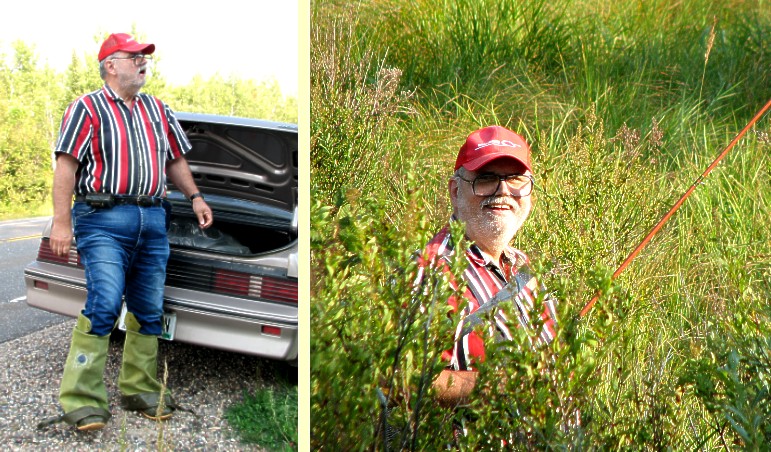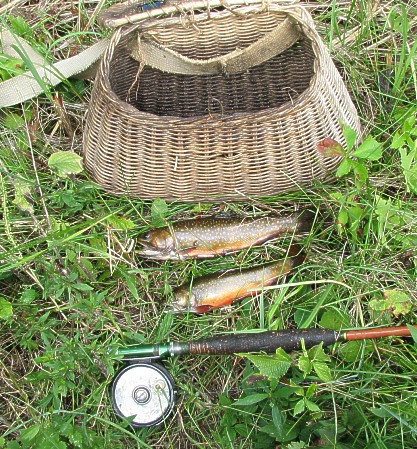
Kansas Snapshots by Gloria Freeland - Aug. 19, 2011
"Wouldn't be the worst way to go"
On the way to husband Art's family reunion a couple of Sundays ago, Art took a small detour and showed me one of the places where he fishes for trout. Since neither he nor the car he drives is so young any more, I've been pressing him in recent years to show me where he goes in case I have to call in the reserves.
His interest in trout fishing was sparked 58 years ago this month. He had gone lake and ice fishing with his dad for a number of years, but his dad figured the tall grass and uneven ground might be a bit too much for the youngster and so he had never taken him fishing for trout. But on that August day in 1953, things changed. His dad returned home and showed him a nice brook trout he had caught. The smooth black skin peppered with bright red and yellow spots fascinated Art, so he asked his dad to take him along the next time.
Thus began 30 years of trout fishing together.
In fact, by the time Art turned 13, his dad suggested they sell their boat as they never used it because all their fishing trips were for trout.
I met Art in August 1987. After we went out a few times, he informed me he was going to Wisconsin on his annual three-week trout fishing and family history vacation. Since I was always interested in family history, I was pretty sure I knew what that was about. But the only thing I knew about trout fishing was from pictures I'd seen in magazines or on television. These invariably featured a picturesque scene of a wide river or lake with a man wading it and casting a fly. So it was natural that I assumed that was what Art did.
When I asked him, he just laughed. Yes, he had done that and, yes, he enjoyed it. But he explained that most of those scenes are set where there are mountains or moderate hills nearby. Brook trout need cold water and. to have enough room to cast, you also need a fairly wide stream. Wisconsin doesn't have mountains and few big hills, so by the time most streams are wide enough to fly fish, the water has been too warmed by the sun to provide a good trout habitat. So most of his trout fishing is done on small streams with nightcrawlers.
Early in our marriage during our visits to Wisconsin, I had the opportunity to see some of the places Art goes fishing. I was surprised to discover that most of the streams are less than six feet across. Often there are places where the tall grass on opposing banks meets, completely covering the stream below.
But while these crystal-clear streams running through woods or grassy fields are indeed picturesque, I have no desire to join him. Because the streams are small, they must be fished from the banks, and the banks are covered by tall grass, bushes or trees. And since trout are wary, an eight-foot long rod is used to keep the fisherman as far from the stream as possible. Trying to weave a long pole in and out of the obstacles while keeping the line untangled doesn't seem appealing.
Then there is the fact that the areas around streams are usually muddy, and sinkholes lurk where a fisherman's leg can disappear to the knee in an instant. Wearing bulky hip boots or settling for continually wet and mucky feet is a requirement. Not my cup-o-tea!
These watery environs are also great breeding grounds for mosquitoes. And in the early summer, each evergreen is potentially a jumping-off place for a wood tick passing time while waiting for a nice warm-blooded lunch to pass by. If that wasn't enough, there is a small, yet distinct possibility of having a face-to-face encounter with a Wisconsin black bear. As daughter Katie might say of all of these, "I'm not a fan!" So I'm more than happy to wave "good bye" when Art heads out to fish and greet him warmly when he brings back our supper.
Still, there is no doubt that small-stream trout fishing is in Art's blood. His mom often said the saddest day of his dad's life was when he had to tell Art he could no longer handle walking through the brush and Art would have to go without him.
Recently, Art mentioned that he just cannot get around in the woods and brush as he used to and that he falls much more than when he was younger. So he knows that his last trip is not too far in the future. And like his dad, it will be a difficult day when he has to hang up his rod and reel for the last time - a rod and reel his dad bought for him when he was 12 years old.
But for now, he still enjoys it. He says there are few things better than being where the only creatures he is likely to meet are deer, otters, raccoons, porcupines, ruffed grouse, turkeys, cranes and hummingbirds.
And he's often said, "If I should die while fishing somewhere, that wouldn't be the worst way to go."

Left: Art surveys the stream standing behind his vintage 1983 fishing car; the bait is
carried in the small green container on his belt. Right, Art
disappears into the brush.

The rod and reel were a Christmas present when Art was 12. He made the creel belt from
a World War II parachute strap. The top fish is considered
a nice catch on a small stream.